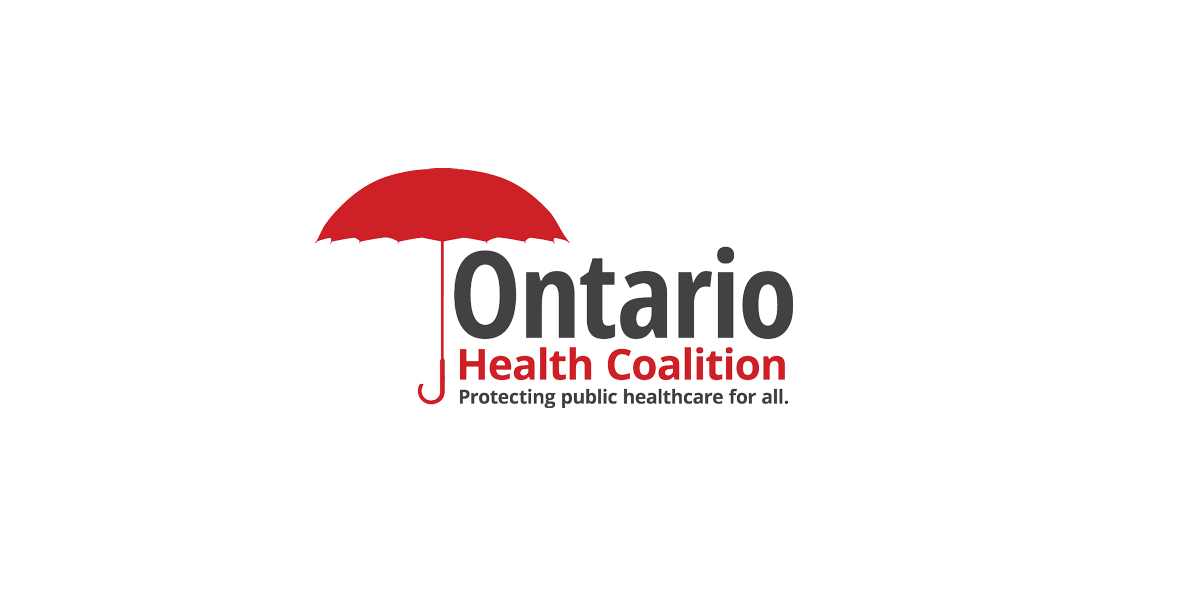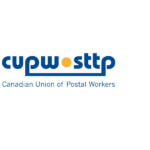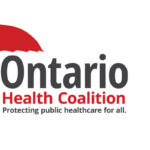
Ontario Health Coalition Public Consultation on Protecting and Improving Local Hospitals
May 14, 2024
In response to unprecedented closures of emergency departments and other local hospital services, the Ontario Health Coalition is holding public hearings across Ontario to develop recommendations for the future of our local hospitals, including a focus on small and rural hospitals.
Most communities have not had any real say in what is happening to our local public hospitals, though we fund, volunteer, support and need them. These public hearings will be just like government public hearings, inviting everyone who is interested to bring a submission, written or verbal, and give their ideas and input. They will be on the record – video and written notes – and will result in a report and recommendations to protect and improve our local hospitals.
The hearings will be an opportunity for municipal leaders, community service agencies, patient advocacy groups, concerned citizens, health care professionals and workers, clinicians and others to give your input.
The hearings are open to all Ontario residents. They will be held in person and there will also be a “virtual” (online) option by Zoom for people to participate.
List of Hearings
You can attend any one you like. You will see some areas overlap and you may want to attend more than one. You do not need to be from that community to attend a hearing there.
Saturday June 8
Welland and Niagara:
9:30 am – 11:30 am, Welland Civic Square Community Room, 145 Lincoln St. Welland.
St. Marys, Clinton, Seaforth, Stratford and region:
3 pm – 4:30 pm, Royal Canadian Legion Branch 236, 66 Church St N, St. St. Marys.
Tuesday June 11
Bracebridge and the Muskokas:
9 am – 11 am, Royal Canadian Legion Branch 161, 168 Muskoka Rd. Bracebridge.
Barrie & Simcoe County:
1:30 pm – 3:30 pm, Barrie Public Library, Angus Ross Room, 60 Worsley St. Barrie.
Wednesday June 12
Mindemoya, Espanola & Manitoulin Island:
10 am – 11:30 am, Mindemoya War Memorial Hall, 6032 Hwy 542, Mindemoya.
Blind River, Algoma & the North Shore of Lake Huron:
3 pm – 4:30 pm, Royal Canadian Legion Branch 189, 27 Hawkins St. Blind River.
Thursday June 13
Almonte, Arnprior, Mississippi Mills, Renfrew County & region:
12 pm – 2 pm, Almonte Civitan Club, 500 Almonte St. Almonte.
Perth, Smiths Falls and Region:
3:45 pm – 5:15 pm, Perth & District Union Public Library, Frizell Room, 30 Herriott St. Perth.
Friday June 14
Campbellford, Northumberland Hills, Peterborough and region:
11 am – 1 pm, Royal Canadian Legion Branch 103, Vimy Room, 34 Bridge St W. Campbellford.
Haliburton, Minden and region:
4 pm – 6 pm, Royal Canadian Legion Branch 129, 719 Mountain St. Haliburton.
Monday June 17
Thunder Bay & the Northwest:
12:30 pm – 2 pm, Mary J L Black Library, Community Program Room, 901 Edward St S. Thunder Bay.
Tuesday June 18
Chesley, Walkerton, Hanover, Durham and region:
10:30 am – 12:30 pm, Chesley Community Centre Community Hall, 129 4th Ave SE. Chesley.
Wingham & area:
2 pm – 3 pm, North Huron Wescast Community Complex, Hot Stove Lounge Meeting Room, 99 Kerr Dr. Wingham.
Mount Forest, Palmerston, Listowel, Durham and region:
4:30 pm – 5:30 pm, Royal Canadian Legion Branch 134, 140 King St W. Mount Forest.
Deadlines & How to Make a Submission to the Expert Panel
You can make a written submission or you can give a verbal presentation to the expert panel that will attend each hearing. All submissions can be as formal or informal as you would like. We have prepared the following guide with questions to help you. You do not need to answer all questions. We will accept letters, or short statements, as well as longer, more formal submissions. What is important is that people have their chance to give meaningful input into the future of our communities’ local public hospitals.
If you would like to make a verbal presentation to the expert panel, please register and we will get back to you to confirm your time slot. The deadline to register to make a verbal submission is May 31 at midnight. Please email us at info@ontariohc.ca with HEARINGS REGISTRATION in the subject line and give your name, email, phone number, and address. Verbal presentations will be 7 minutes maximum followed by a chance for the expert panel to ask questions or discuss ideas with the presenter. (This is not adversarial! We are there to hear from you. Questions will simply be to clarify information, or get your thoughts and ideas.)
If you would like to make a written submission, please email it to the Ontario Health Coalition at info@ontariohc.ca by June 20 at 5 p.m. Please include your name, email, phone and address with your submission so we can confirm with you the receipt of your submission and send you the final report and recommendations.
_______________________________________________
Below is a short briefing note about the background and context for the public hearings followed by a consultation guide to help you write your submissions. Printable versions attached.
Ontario Health Coalition
Backgrounder
Unprecedented Closures of Local Hospital Services
May 14, 2024
In Ontario, vital hospital services, such as emergency departments, maternity and obstetrics, outpatient laboratories and intensive care units, have been subject to repeated closures in the last three years. These closures are unprecedented and they are worsening. The duration of closures is getting longer. Multiple towns across regions are closing vital services at the same time. Public notice is often last minute. Remote communities in the north are experiencing long term closures of vital services such as labour and delivery and outpatient laboratories, and repeated emergency department closures or threats of closures. Rural communities across mid-Ontario and the south are particularly hard hit, but we are also seeing closures of vital services in the largest cities of the province. Emergency departments in particular are being repeatedly closed down in the daytime, overnight, on weekends, or for days to weeks.
The Ontario Health Coalition released a report tracking closures at the beginning of December 2023.
The rates of closure are staggering. From January 1 to November 24, 2023, there had been at least:
- 868 emergency department closures;
- 316 urgent care centre closures;
- two outpatient laboratory closures;
- eleven obstetrics unit closures;
- one ICU closure, and;
- one labour and delivery unit closure (long-term).
In total, there were 1,199 closures of vital health care services from January 1 to November 24. In other words, these services in Ontario have either temporarily or permanently closed in 1,199 instances this year so far. Consequently, 30,155 hours of care (equivalent to 3.44 years) have been lost to local communities this year so far.
A growing number of local hospitals are at risk of permanently losing services. As a result, the Ontario Health Coalition is working with local communities and coalitions across the province to conduct public hearings on saving local hospitals. The goal is to come out with a report and recommendations to save our local hospitals and their services at minimum, and also to restore stability, revitalize them, improve access, quality, equity and responsiveness of hospital care in our communities. We will then work our hardest to get the recommendations adopted and implemented to save and revitalize our local hospitals.
_______________________________________________
Ontario Health Coalition
Public Hearings on Local Hospitals
Consultation Document
May 14, 2024
The following consultation document is a guide to help in drafting submissions for the hearings. It is not meant to be limiting – please include any and all information and recommendations you would like to submit. You are also welcome to bring an informal submission – your story about your family’s access to hospital care in your area, a letter, or point form notes. You do not need to answer all questions – this is just a guide to help guide the types of issues we are hoping to hear about.
Access to care
Provincial government decisions to cut or curtail public hospital funding have contributed to the crisis. Long term policies of underfunding hospitals in order to downsize them meant that Ontario had no surge capacity left by the beginning of the pandemic. Ontario has the fewest hospital beds per person left of any province in Canada and funds hospitals at the lowest rate in the country. Despite promises to end hallway medicine and not to cut public services, when the current government was elected it imposed a new round of austerity and real-dollar cuts to public hospitals. While the government provided extra funding during the early years of the pandemic, it cancelled COVID funding in the 2023 budget, imposing austerity again. In 2023, global budgets for hospitals in Ontario is increasing by only 0.5%[1] while health care inflation increased by a range of 5.65%[2] to 3.5% a real-dollar cut, pushing hospitals into deficits, forcing hospitals to downsize their services and continuing downward pressure on wages for staff that are already in crisis-levels of short supply. This policy choice is about cutting and constraining public health care funding, yes, but it is also about closing down public non-profit capacity and privatizing it. At the same time as public hospitals are facing real dollar cuts, the provincial government has vastly increased funding for for-profit clinics[3] and hospitals, and for for-profit staffing agencies.
| Describe the current situation: 1. Can you tell us what hospital services residents in your region have problems accessing? 2. What services have been removed or are experiencing closures in your local hospital(s)? Over what period of time? 3. How are residents dealing with problems in accessing these services and what does it mean for access to care, cost for patients, and their health status? 4. Are there any services that your local hospital has gained or any services that have been expanded? Over what period of time? If any, what has this meant for local residents? Recommendations: 5. Which hospital services should be provided and within what travel distance? 6. What services (existing or not) are or should be particular to this community that are important to keep for cultural, demographic and specific local contextual reasons? |
Staffing
The immediate cause of local hospital services closures is most often cited as staff shortages including nurse, health professional and physician shortages. Staffing shortages that were emerging prior to the pandemic have grown over the last three years into the worst crisis anyone has seen. The staffing crisis has been compounded by public policy choices that have actively undermined staffing efforts, including wage suppression legislation (Bill 124), privatization of staffing through for-profit staffing agencies, the government’s decision to end emergency COVID funding for locums and other funding, and extremely short-term funding arrangements announced after short staffing has become critical.
| Describe the current situation: 1. Are there staffing shortages at your local hospital(s)? These might include nurses, health professionals, doctors, support staff. What types of staff are short? Is it getting worse/better? 2. What types of recruitment efforts are underway? Are recruitment efforts real? Are they effective? 3. What types of efforts are underway to retain staff and keep them from leaving, if any? Are they effective? 4. Are private staffing agencies having an impact on local hospital staffing? On the local hospital budget? Please describe the impacts. 5. Are you paying locally to recruit staff in competition with other communities? Can you describe what your community is funding locally to recruit staff? 6. Describe the costs and consequences, if any, resulting from competition with other communities for health care staffing. Recommendations: 7. What can be done locally or by the provincial government to restore stable staffing if it is a problem in your community? 8. What services are critical for your local hospital to have to improve the recruitment and retention of health professionals? |
The Role of the Local Hospital
For more than a hundred years, communities across Ontario have fundraised, advocated, and built their local hospitals in an effort to establish needed services close to home. Hospitals have other local benefits also. In his autobiography, Paul Martin Sr., Minister of National Health and Welfare, who saw this program as the essential foundation for the eventual introduction of a public health insurance system in Canada, described his commitment to the creation of a National Health Grants program (1948-1971) to build community hospitals as follows:
“The grants would correct the unequal distribution of beds across the country, and particularly the dearth of hospitals in rural areas. Because poor facilities discouraged medical personnel from moving willingly to more remote parts, new, strategically placed and up-to-date hospitals would induce practitioners to go where they were needed most.” (Paul Martin Sr., A Very Public Life Vol.II, 1985)
For many communities, hospitals are central to the economic life of the community and have advanced equity in access to care.
| Describe the current situation: 1. What does the hospital mean for your community? What role(s) does it play in the life of your community? 2. Has this improved/not improved? How and why? Recommendations: 3. What would the hospital as a hub for healthcare mean in this community? 4. What local innovations (existing or not) should be noted and protected? 5. What hospital and healthcare infrastructure is necessary to promote a robust social and economic life in this community? |
Local Hospital Governance
Hospitals across Ontario have not only been subjected to the most radical downsizing of any province in Canada, they have also experienced very significant loss of local decision-making and control. In a number of communities, hospitals have been amalgamated into larger hospital corporations and local boards have been decommissioned or reduced. The rationale for amalgamation was to find administrative savings but amalgamation has had a huge impact on local services also. In more recent rounds of hospital cuts and restructuring, local hospitals have lost an array of services, and now are facing the loss of core services that define them as hospitals. Some are being closed down entirely.
| Describe the current situation: 1. Is your local hospital amalgamated? If so, what has amalgamation meant for your local services and access to care? What has the impact been on your local voice in decisions that impact access to care? 2. If your local hospital is amalgamated, has amalgamation improved access to care, democracy, responsiveness, equity or quality of care? Who has benefited the most from amalgamation? Who has lost the most? 3. Whether your local hospital is amalgamated or not, has the governance of your local hospital improved/not improved? Over what period of time? How and why? Recommendations: 4. Should local hospital boards be elected? Who should be members of a local hospital? 5. What improvements to democratic governance of the local hospital should be adopted? |
Provincial Leadership and Standards
In each round of hospital cuts and restructuring, the provincial government has set processes and at least some standards for how hospitals are to make decisions regarding local services. They have been far from adequate, but they did exist. On multiple occasions, the Minister of Health intervened to stop the closure of local services, and certainly at no time has a provincial government indicated that it is not responsible for planning service levels and resourcing Ontario’s hospitals. In today’s unprecedented situation of hospital service closures, there has been a major difference. In response to the permanent closure of the Minden hospital emergency department, in existence since 1956, the Minister said it is a local decision. The failure of the provincial government to take responsibility for planning, recruiting and retaining needed health care staff, dealing with crises and setting standards for access to the most urgent of health care services is at odds with the approach of Ontario’s governments dating back at least forty years.
| Describe the current situation: 6. Has the provincial government intervened to stop service closures or cuts, restore services, or to deal with staffing shortages in your local hospital(s)? 7. Are provincial government leadership, support and standards adequate to ensure that you have the local hospital services, quality and access to care, equity and democratic input that your community needs? Recommendations: 8. Would it help to have a required basket of services that must be provided in all local hospitals? If so, please provide any input you have on which services should be provided and within what travel distance? 9. Please share your recommendations for what the provincial government should do to help save, rebuild and revitalize your local hospital services? What resources does your local community need? What protections for improved equity in access to care or improvements in quality of care and democratic governance should there be? Any standards you would like to recommend? |
Footnotes:
[1] Total budgeted funding for hospitals in the 2023/4 Ontario government Estimates (i.e., including all four line-items cited above) was $23,773,093,800, while it was $23,657,635,000 in 2022/23. This is an increase of $115,458,800 or 0.488%. The Estimates can be found here: https://www.ontario.ca/page/expenditure-estimates.
[2]Statistics Canada reports that health care inflation was 5.6 percent (measured September 2022 – September 2023) declining to just over 3.5 percent by December. Source: Statistics Canada. Table 18-10-0004-08 Consumer Price Index, monthly, percentage change, not seasonally adjusted, Canada, provinces, Whitehorse and Yellowknife — Health and personal care
[3] In contrast, so called “Independent Health Facilities” (i.e. private, for-profit surgical and diagnostic facilities) are budgeted to get a 212% increase from last year’s Budget Estimates.
It is a boom for private profits, even as the government implements austerity for public hospitals. As shown in the 2022/3 and 2023/4 Estimate charts, IHF budgeted funding increased from $38,693,100 to $120,693,100. That is an increase of exactly $82 million – or 211.92%. In dollar terms, they budgeted almost as much of an increase to the tiny IHF sector ($82 M) as they did for the entire hospital sector ($115.5 M).







